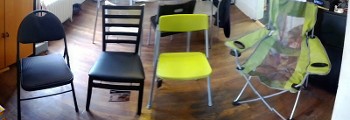Folding chair
From DDL Wiki
Contents |
Executive Summary
Group Member Information
Joe Wynant - DFMA
Tammy Dvir - DFE
Sarah Kunka - FMEA
Mark Sandusky - Stakeholders Liaison
Will Maher - Team Leader
Stakeholder Wants and Needs
Consumer
Their are many different consumers who require a folding chair. For our study we are focusing on two main groups. First the consumer who buys a chair for his own use, i.e. for special events, dorm rooms or for outdoor seating. The second consumer is one who uses it for business needs i.e. renting out chairs, restaurants or large event facilities. We believe that both consumers have similar wants, these wants are shown below.
- Comfort
- Portability
- Weight
- Nesting
- Cost
- Storage
- Ergonomics
- Safety
- Stability
- Durability
- Ease of use
- Adjustable
- Aesthetics
- Style
- Features
- Cup holders, armrests, etc.
Retailer
Retailers are looking for a chair that can be sold quickly and take up minimal floor space while at their store.
- Marketability
- Unique product that makes it easy to sell
- Storage/”stack-ability”
- Weight
- Durability
- Returns a profit
Manufacturers
Manufactures want a chair that is cheap and easy to produce.
- Materials
- Easy to manufacture, cheap, or eco-friendly
- Cost efficient processes
- Design that is easy to manufacture
- Simple parts, low number of parts, easy to assemble
Shipping/Transport
Transports companies will also want certain qualities of the chair and its packaging.
- Weight
- Packaging
- Space efficiency, smart packaging
- Durability of packaging and product
Usage
The folding chair product is quite simple to use and store. Four different models of the folding chair were observed and analyzed for the use study. Operation of each of these models is extremely similar and for the most part exactly the same. However, the team documented the good and bad aspects with each of the models as well as how certain features present in each model compared with one another.
Chair 1
This product was relatively simple to use; the folding mechanism was easy to operate. The chair unfolds easily without much internal resistance from friction for the sliding mechanism. There were no major complaints on using this chair other than the fact that it is a little awkward to carry around. One interesting to note about this chair is that it features a lokcing mechanism that is activeated when the chair is fully unfolded. This mechanism insures that the chair does not accidentally fold again; however it it easy to unlock making it a worthwhile feature.
Mechanical Function and Parts
Bill of Materials
Design for Manufacturing and Assembly
Failure Mode and Effect Analysis
| Item & Function | Failure Mode | Effects of Failure | S | Causes of Failure | O | Design Controls | D | RPN |
|---|---|---|---|---|---|---|---|---|
| Seat Front Rivet - connect front leg to seat | shear | seat will drop | 8 | excessive weight | 3 | sticker warning against excessive weight | 2 | 48 |
| individual testing in plant | 1 | 24 | ||||||
| fatigue | 3 | 1/100,000 chairs fatigue tested | 4 | 48 | ||||
| improper insertion of rivet | 2 | employee training | 2 | 32 | ||||
| visual inspection | 4 | 64 | ||||||
| material flaw in rivet | 2 | visual inspection | 6 | 96 | ||||
| misuse | 4 | warning stickers | 2 | 64 |


